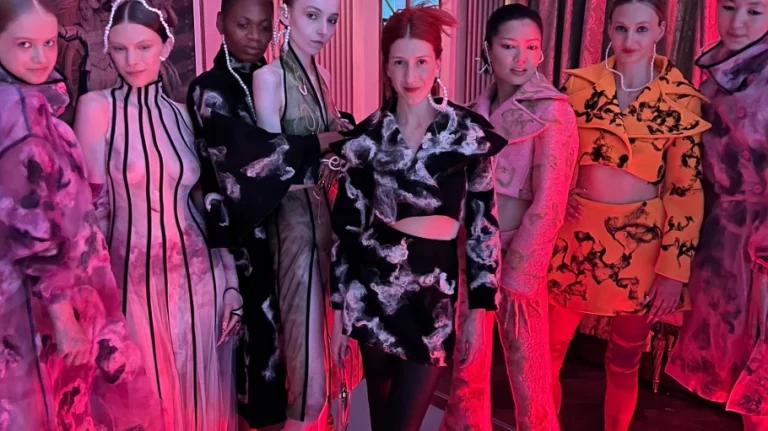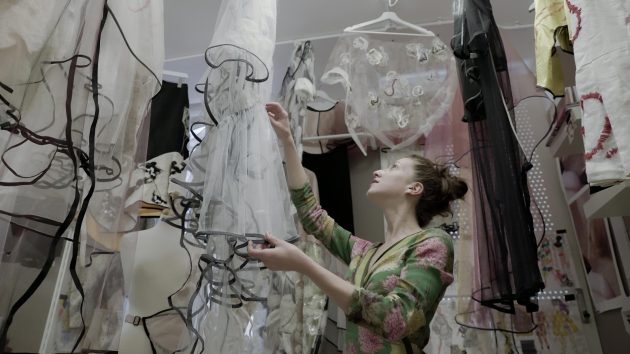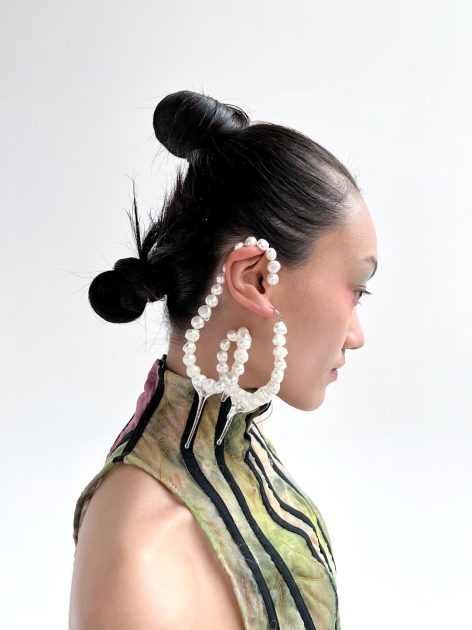
“Clothes Connect You With People.”: In Conversation With Argentine Designer Clara Pinto
18 June, 2022Clara Pinto is a fashion and textile designer from Argentina. She creates fabrics with unusual materials such as leftover bones, animal hair and degradable bio-plastics. After completing her training in Buenos Aires, she immediately moved to London where she worked for Martine Jarlgaard and Peter Piloto, before attending a textile residency in Iceland, and then setting up her own ready-to-wear label. Her work has featured in Vogue Italia, Elle, and Marie Claire amongst others, and she was selected to work with Sarabande, the Lee Alexander McQueen’s Foundation. Clara recently participated in London Craft Week, where she showed her latest collection at the Argentine Ambassador’s Residence. I caught up with her for a chat in London.
You’ve said that you’re not a fashion or a textile designer, but something in between. Would you describe yourself as an artist?
If you design clothes you can’t really say that you’re exclusively an artist. You have to engage with certain things.
Last year I participated in Crafting Business programme for emerging makers run by the Craft Council. Before I used to do bespoke, but after completing the programme – they take you and mentor you in different areas – I came out with a business plan. It transformed my career. Marketing, media training, they are all things you learn as you go, but I began my work very impulsively. I was just creating, creating, creating.
As a result of this course my business started to take shape and I started working within the fashion circuit.
So you became more commercial, as opposed to before when you were purely a creative?
Creating textiles is a moment of pure joy for me, I love it and it’s where I find my greatest creative flow. You could say I was working as an artist when I was focusing on my fabrics, but that’s not sustainable for someone who makes clothes. I find the fashion industry fun: it’s fast, enriching, and an incredibly strange social phenomenon. I asked myself what would happen if I try to do this. I believe in my work and I think I’m bringing something different to the table in terms of fashion, and London is the best place for me for to do that.
Why did you choose to come to London from Argentina?
Before I graduated I made a short trip to Europe to check out which of the fashion capitals would best suit my work. I realised it was here in London. This is a very eclectic city with lots of spaces given over to fashion, for example in Dover Street, or with the new owners of Selfridges.
You took workshops and courses as a child, including one with the Argentine artist Nicola Costantino. When I saw your work I was actually reminded of her.
I was 12 years old when I started her workshops and I studied for two years with her. She was just starting to work with children – later she had an artificial insemination and had a child. It was kind of revolutionary in the industry.
I used to go and take tea with her and sit on a sofa and was surrounded by sculptures in the shape of breasts… Everything in her house revolved around her art and there were dead calves hanging from the ceiling, that kind of thing. After two years of seeing that I became desensitised to it all and lost any feelings of repulsion. Instead I saw beauty there.
In her documentary Nicola Costantino, La Artefacta, there’s a part where she talks about making soap out of her own fat.
She was doing that just at that time.
You also worked in a butcher’s when you arrived in London.
It wasn’t really a butcher’s! My decision to move here was so impulsive that I didn’t really have any kind of financial backup. So I had to find work straight away. I went to a café and they asked me if I wanted to be the chef. They had like 20 different types of meat there. I was mainly working with the cutting machine – filleting the meat. I was also handling it, which I liked.
You’ve also made textiles out of bones from the asado.
Yes, but that was before, for my graduation show. I thought it would be fun to work with bones instead of beading or embroidery. It was all about working with texture. So I started looking for different animals. I was constantly boiling bones and asking friends to bring me any leftovers from what they’d eaten. The bones would disintegrate and it ended up being pretty cool.
That’s where the question of whether you’re an artist or a fashion designer comes into play: you have to decide how far you can push the limits of what people can tolerate. Nicola is an artist and she takes things to an extreme, but that’s her audience and how she makes her mark. I’m a fashion designer and I can’t work with bones. I mean, I could, but my clothes already make a statement without needing to go there. But my experience with Nicola definitely shaped me.

So would you say that you are responding to the demands of the market?
You have to be commercial to some extent because you are doing fashion, not art. I can work with hair and bones and make beautiful things that would be featured in editorials, but that’s not going to be enough for me to survive.
It’s the same with any of the big name designers. Take Alexander McQueen – he was highly creative but it was all for the shows. That’s what it is to be an intelligent designer. It’s not just about doing something new and being caprichoso (wilful – I love that word because it is so applicable). But it feels good when you start to sell and it’s stimulating. You see that people relate to what you’re doing.
It’s a form of recognition.
Yes, exactly and this course (Crafting Business) put that into perspective for me.
But if you’d started with the business and then tried to be an artist it wouldn’t have worked.
I love and value everything I learnt in Argentina. I’ve also realised it made the difference because I didn’t come from the schools here where they teach these things. Students here might create these crazy collections but then they go straight to jobs with the big brands. They are much more conscious about what they’re doing.
How do you think Argentina shaped you?
Argentina gave me a lot of freedom. When I went to university it was really valued to do something different and innovative, but that wasn’t necessarily commercial. They didn’t ask you to be that. It’s not that innovation isn’t valued here, but there’s so much competition and a desire to be number one, that people can lose their way creatively. They get sucked in to the trends.
I think part of the reason I’ve had so much support – from the Craft Council and the free space at London Craft Week – is because my work comes from a different place and is authentic in that way.
When you arrived did you have an idea of what you wanted to do here?
I had a route mapped out in my head. It’s so beautiful to move forward on a path that you’ve chosen and I feel so proud every time I achieve something. I know it’s going to take some time. My clothes are very niche and it’s a business that I’m developing by myself so I’m just taking it step by step. But I am very clear about what I want and every decision leads me on to the next thing.
I also realised that if you present a project and it has a purpose there is a place for it to be supported. It’s made me extremely grateful. There are so many things I might not have done, or learnt, or connected with otherwise.
I wanted to ask you about your time in Iceland, as it seemed to be a turning point for you. How did you get there and what made you decide to go?
I started working at Peter Piloto as a junior and it was very intense. I was working all hours and going to bed every day at 3 am. I remember there was a moment with my boss. She had a child with a disability and had to go to Germany for the operation. She was away for three day but called 24 hours a day. Her son was in a critical condition and she was still totally connected to her job. I saw what the industry demanded and I wasn’t sure if it was for me, if I was cut out for that. It scared me.
So I decided to leave and do this residency in Iceland. And suddenly I was in a completely different headspace. I worked constantly and went into a creative ecstasy because it was the first time I’d done anything of my own for a really long time. So then my Argentine side came out and I went to the butcher and I asked for the horse tails.
You already knew about the tails and that you wanted to use them?
Yes, I’d heard about it because they eat horses there. This was very far in the north, not in Reykjavik. They are sustainable villages where with their own butcher, fishmongers and so on.
I went to pick up the tails and it was snowing and they’d left a black bin bag outside the shop. When I picked it up there was a huge pool of blood. I’d imagined they’d literally give me a ponytail, but instead they’d cut out the muscle with the tail attached to it. But I thought, OK, it’s a piece of meat; I’m a piece of meat too. So I went to the river to clean it. I remember that moment: I was brushing the horse tails in the river and thought: “This is it, this is what finding a material is all about”. That’s when it all made sense to me. They slaughtered maybe six horses a month and I thought, let’s honour these creatures and that was my way of doing so. Also, I believe you are more motivated when you know where something comes from.
You’ve talked about finding a connection with the material you are working with.
I strongly believe that! I don’t want to make clothes that will be thrown away. The added value is in the fabric. It is very important for a person to be able to say, this was created in this way, and dyed like this, and talk about their clothes in that way. Clothes are amazing and beautiful and they connect you with people. If you have beautiful clothes you will meet people. It’s magical what happens with clothes. The challenge is making people believe and understand that.

You said you preferred designing textile to clothes?
I think it is more instinctive to design textiles. I feel that’s my calling. But I’m passionate about what I’m doing, it’s fun that the clothes I make people wear and that I’m developing a business. It is very enriching. It’s the life I want to live during these years of energy when I’m really motivated. But if I close my eyes and look at how my life might be in 20 years’ time it would be in a calmer place. This is a very demanding industry. I chose this path because I love it and it’s giving me everything, but I’m also looking forward to the other stuff. Textile is where my heart is perhaps.
Find out more at: https://www.clarapinto.com
Follow Sounds and Colours: Facebook / Twitter / Instagram / Mixcloud / Soundcloud / Bandcamp
Subscribe to the Sounds and Colours Newsletter for regular updates, news and competitions bringing the best of Latin American culture direct to your Inbox.

